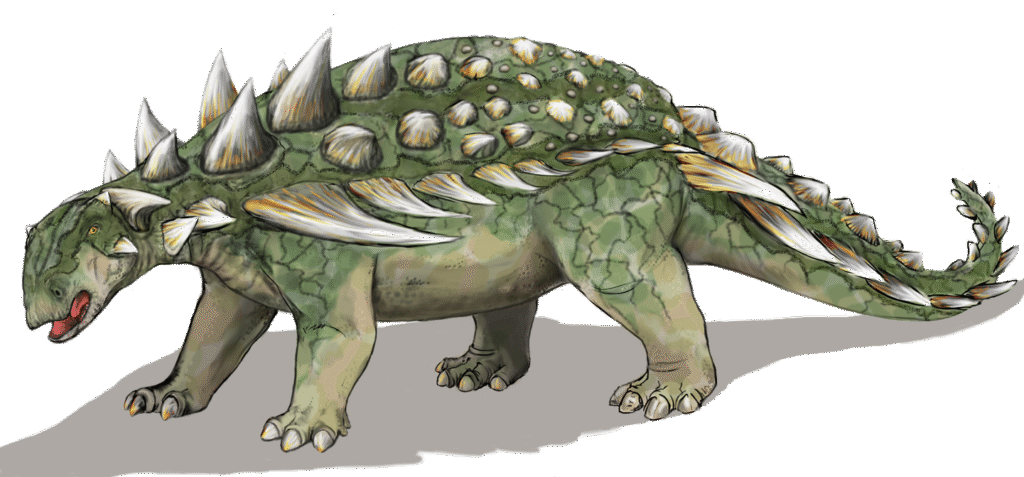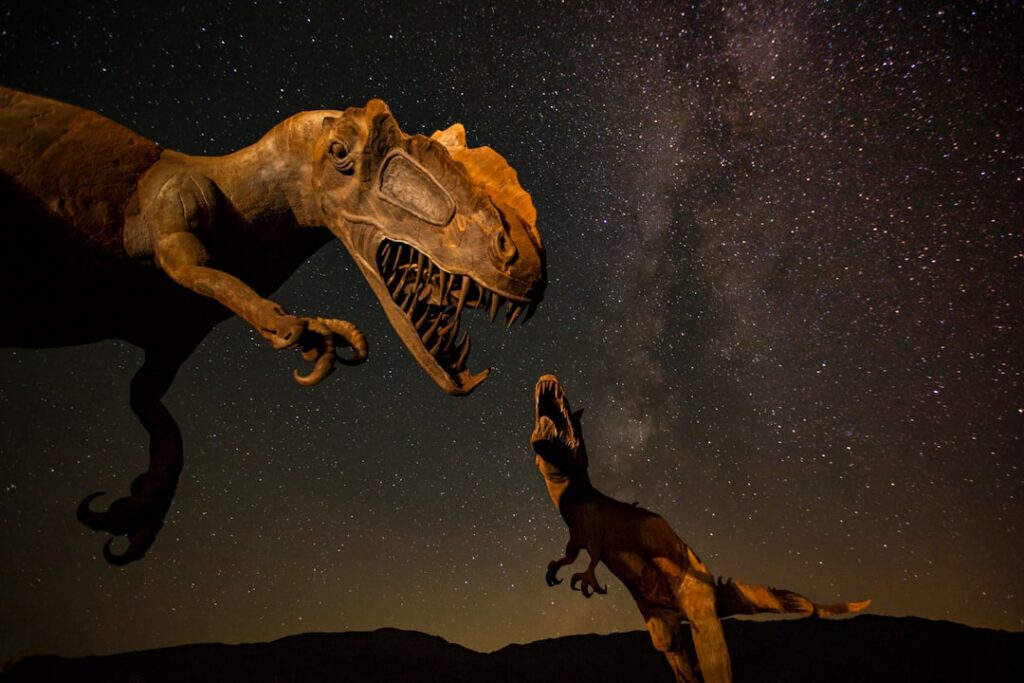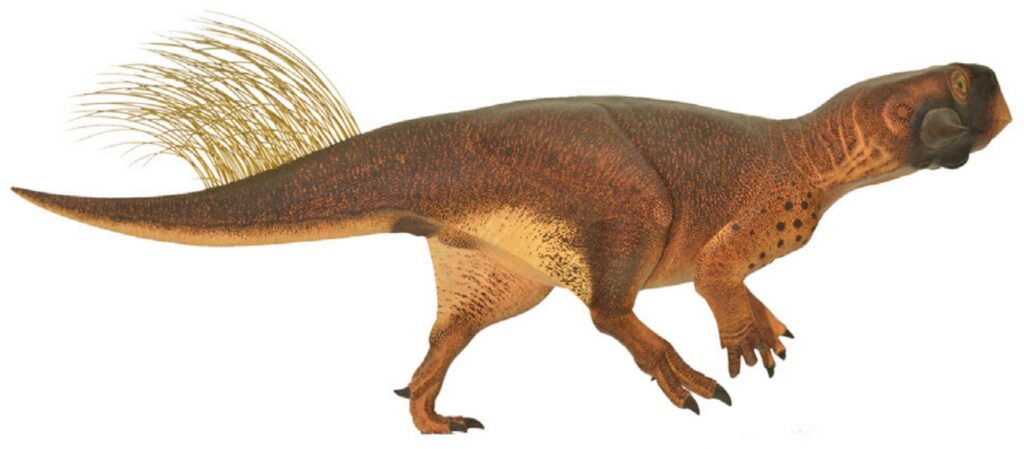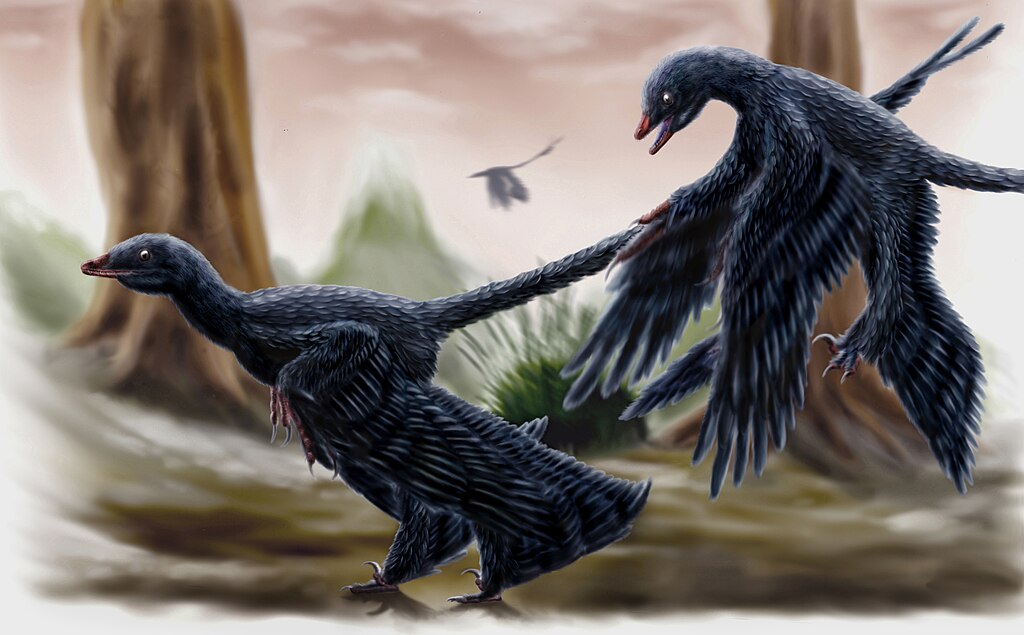Picture a world where roamed as living tanks, their bodies covered in protective armor that could rival any medieval knight’s suit. This isn’t fantasy; it’s the incredible reality of Thyreophora (“shield bearers”, often known simply as “armored “), a remarkable group of that dominated prehistoric landscapes for over 135 million years. All thyreophorans are characterized by parallel rows of special bones, embedded in the skin, called osteoderms (osteo – bone; derm – skin), that run down the necks, backs, and tails. The group is dominated by two great clades: Stegosauria (stego – roof); and Ankylosauria (ankylo – fused).
These fascinating creatures ranged from small, nimble animals to massive, lumbering fortresses. What made them truly special wasn’t just their impressive size or plant-eating lifestyle, but their unique evolutionary approach to survival. While other dinosaur groups relied on speed, intelligence, or sheer size, thyreophorans chose the path of ultimate defense. Let’s dive into the world of these armored giants and discover ten remarkable examples that showcase nature’s most impressive biological armor systems.
Scutellosaurus: The Little Shield Bearer

The Scutellosaurus (little shield lizard) is among the earliest known Thyreophorans. This dinosaur lived in western North America during the Jurassic period about 200 million years ago. It is known for being small, only about 1.5 meters long and 22 pounds, and having a slender tail. The Scutellosaurus had small armored plates on its back.
Picture this tiny pioneer as the ancestor of all the mighty armored that would follow. Unlike its massive descendants, Scutellosaurus could actually walk on two legs when it needed to move quickly, though it spent most of its time on all fours browsing for food. The armor plates scattered across its back were relatively modest, more like protective bumps than the elaborate shields we see in later species. Still, this little dinosaur represented a revolutionary evolutionary experiment that would eventually lead to some of the most heavily armored animals ever to walk the Earth.
Scelidosaurus: The Pioneering Armor Bearer
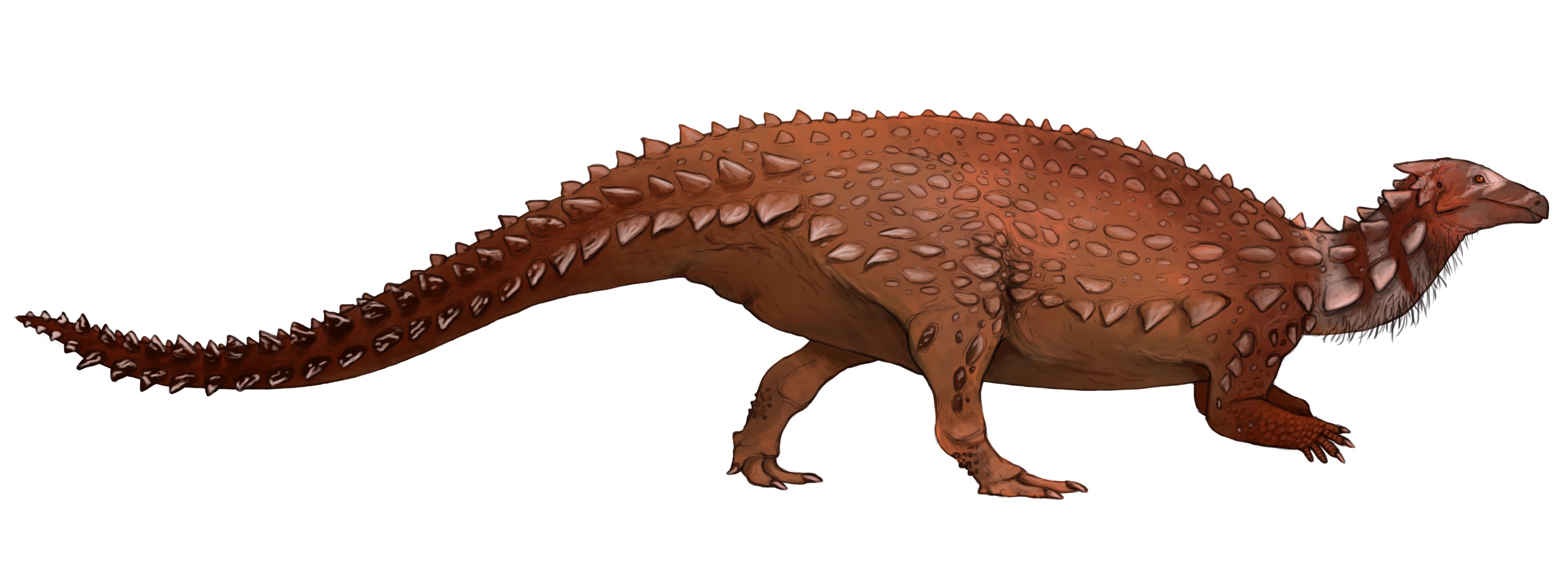
The next armoured dinosaur we know about was Scelidosaurus which was the closest relative to Ankylosauria and Stegosauria. Like Scutellosaurus, Scelidosaurus lived during the Early Jurassic Period 191 million years ago, but lived in Europe. This dinosaur marked a crucial evolutionary step between the early, lightly armored forms and the heavily protected giants that would dominate later periods.
Measuring roughly four meters in length, Scelidosaurus was significantly larger than its predecessor Scutellosaurus. Its body was covered with rows of bony studs and small spikes that provided much better protection than earlier forms. What makes Scelidosaurus particularly fascinating is how it represents the branching point where thyreophorans began to commit fully to the armored lifestyle. Among primitive thyreophorans, Scutellosaurus was likely primarily bipedal, while the more quadrupedally adapted Scelidosaurus may have been bipedal for some of the time, particularly as a juvenile. Stegosaurs and ankylosaurs are thought to have been obligately quadrupedal. This transitional nature makes it one of the most important for understanding thyreophoran evolution.
Stegosaurus: The Iconic Plated Giant
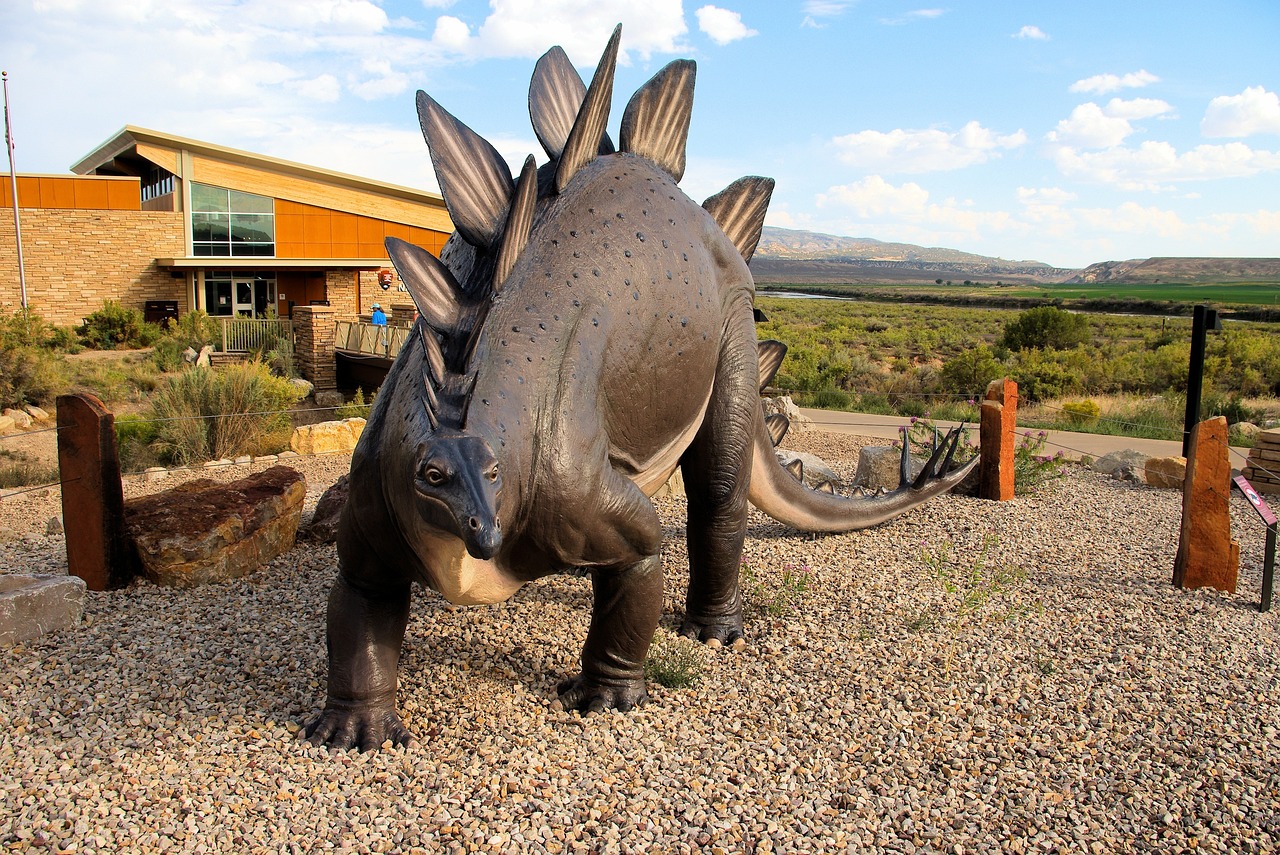
One of the most famous thyreophorans out there is the iconic Stegosaurus. This is probably the most famous Thyreophoran dinosaur which lived in the Late Jurassic Period 150 to 145 million years ago and was discovered and named by Othniel Charles Marsh in 1877. Stegosaurus grew to roughly the length of two cars and weighed one and a half tons. It had a spiked tail made up of 4 spikes that were between 60 – 90cm (2 – 3 feet) long and would have done a lot of damage to its predators if it caught them at full velocity. Stegosaurus’s plates on its back were similar to roof tiles and therefore its name meant “roofed lizard” and was by far its most distinguishable feature.
The plates of Stegosaurus remain one of paleontology’s most intriguing mysteries. Today, scientists believe they were more likely used for display, to help male stegosaurs impress females, or to help different stegosaurs identify each other. Imagine these massive creatures using their spectacular back plates like colorful billboards, advertising their fitness to potential mates or warning rivals to stay away. It is established that the Stegosaurus has a thagomizer, a collection of spikes near the tail utilized as a defense measure. In general, the Stegosaurus armament evidences aggressive protection. Despite its impressive size and formidable appearance, Stegosaurus had a brain roughly the size of a walnut, proving that sometimes in evolution, armor matters more than brains.
Kentrosaurus: The African Spike Master

There were many thyreophorans during the late Jurassic Period, including the incredibly spiky Kentrosaurus. This stegosaurian dinosaur lived around 152 million years ago in Tanzania. It grew around 15 feet long and weighed around 1 ton, with a double row of small plates covering its neck and down its back. When the plates reached the dinosaur’s hips, they merged into larger spikes that covered its hips and tail.
What truly set Kentrosaurus apart from its North American cousin was its weapon arsenal. What’s really neat about the Kentrosaurus, however, is that it had unusually long spikes on each of its shoulders. Picture this dinosaur as nature’s version of a medieval knight’s armor, but taken to an extreme that would make any blacksmith envious. The transformation from plates to spikes along its body created a defensive system that was both beautiful and deadly. These shoulder spikes could have been used not just for protection, but potentially as offensive weapons, allowing Kentrosaurus to actively fight back against predators rather than simply endure their attacks.
Ankylosaurus: The Ultimate Tank

This dinosaur had a large and wide skull, with horns pointing back and down from the back of its head. The largest ankylosaurus skull discovered so far measured over 2 feet long and 2 feet wide! Its skull and other parts of the ankylosaurus’s body were fused, reinforcing and increasing its overall strength. The end of its tail was also fused, forming a large, weapon-like club. Its neck, back, and sides were covered with bony plates, knobs, and scutes embedded in its skin, giving this iconic thyreophoran a dangerous and formidable appearance.
Imagine encountering this living fortress in the wild. Ankylosaurus was a huge armored dinosaur, measuring about 25-35 feet (7.5-10.7 m) long, 6 feet (1.8 m) wide and 4 feet (1.2 m) tall; it weighed roughly 3-4 tons. Its entire top side was heavily protected from carnivores with thick, oval plates embedded (fused) in its leathery skin, 2 rows of spikes along its body, large horns that projected from the back of the head, and a club-like tail. Ankylosaurus was the last of the ankylosaurids (armored ) to evolve, and the biggest. The tail club alone could deliver a bone-shattering blow that would deter even the mighty Tyrannosaurus rex. This was evolution’s masterpiece of defensive design, a creature so perfectly armored that Flipping it over was the only way to wound it.
Borealopelta: The Northern Shield with Ancient Camouflage
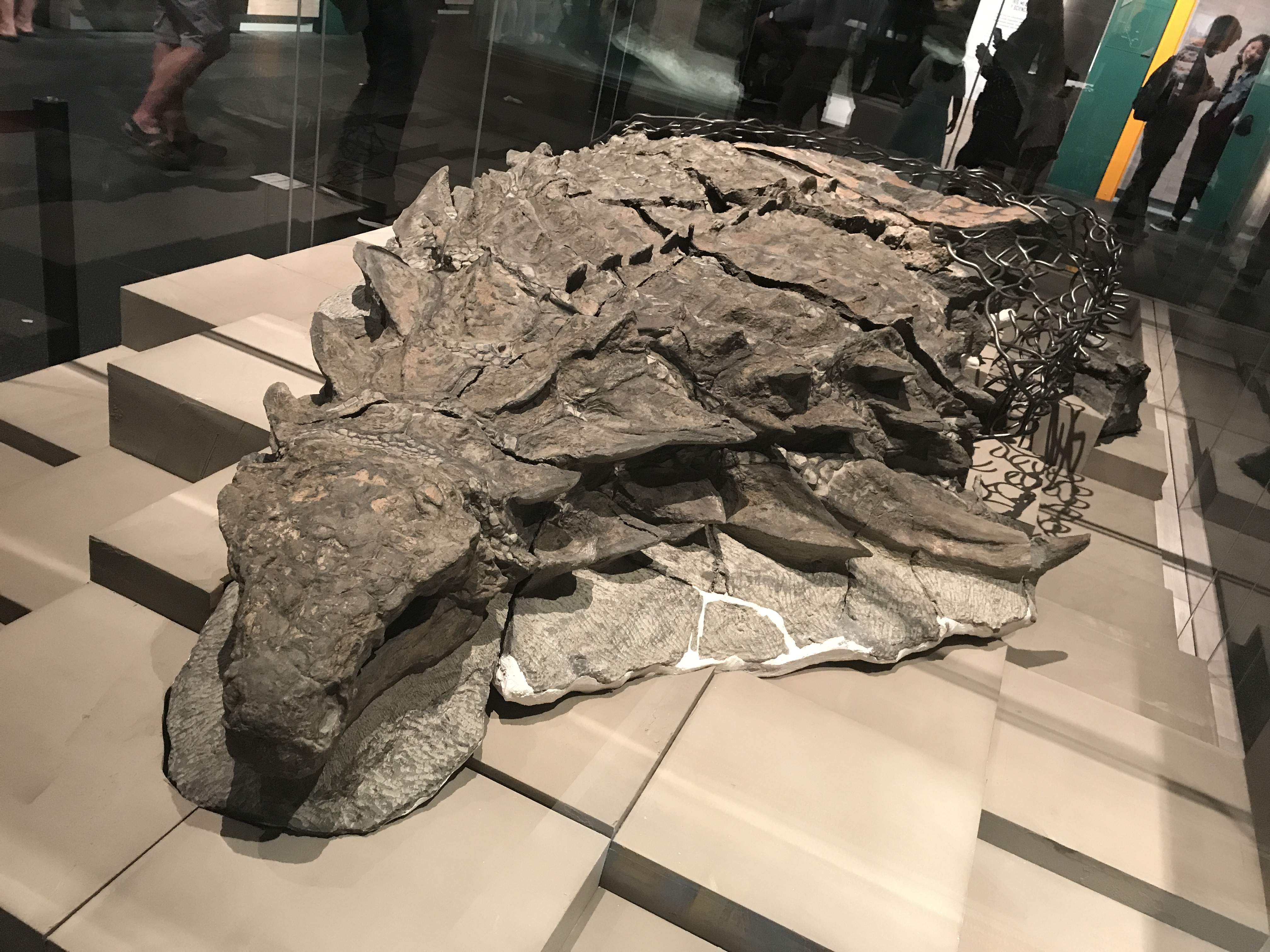
Borealopelta (meaning ‘northern shield’) is a genus of nodosaurid ankylosaur from the Lower Cretaceous of what is today Alberta, Canada. It contains a single species, B. markmitchelli, named in 2017 by Caleb Brown and colleagues from a well-preserved specimen known as the Suncor nodosaur. Discovered at an oil sands mine north of Fort McMurray, Alberta, the specimen is remarkable for being among the best-preserved dinosaur fossils of its size ever found. It preserved not only the armor (osteoderms) in their life positions, but also remains of their keratin sheaths, overlying skin, and stomach contents from the animal’s last meal. Melanosomes were also found that indicate the animal had a reddish pinkish skin tone.
What makes Borealopelta absolutely extraordinary isn’t just its preservation, but what it revealed about dinosaur behavior. The discovery that Borealopelta possessed camouflage coloration, indicates that it was under threat of predation, despite its large size, and that the armor on its back was primarily used for defensive rather than display purposes. Think about this: a heavily armored, tank-like dinosaur still needed to hide from predators! Examination of the specimen’s stomach contents indicates that ferns were a major part of the animal’s diet. The fact that ferns made up the majority of Borealopelta’s last meal suggested that it was a highly selective feeder. Roughly six percent of the stomach contents contained charcoal as well, leading to the conclusion that Borealopelta was feeding in an area that was experiencing regrowth after a recent wildfire. This gives us an incredible snapshot of life 110 million years ago, complete with the dinosaur’s final meal.
Sauropelta: The Lizard Shield Pioneer

Sauropelta (/ˌsɔːroʊˈpɛltə/ SOR-oh-PEL-tə; meaning ‘lizard shield’) is a genus of nodosaurid dinosaur that existed in the Early Cretaceous Period of North America. One species (S. edwardsorum) has been named. Anatomically, Sauropelta is one of the most well-understood nodosaurids, with fossilized remains recovered in the U.S. states of Wyoming, Montana, and possibly Utah. It is also the earliest known genus of nodosaurine; most of its remains are found in a section of the Cloverly Formation dated to 108.5 million years ago. Sauropelta is a medium-sized nodosaurid, measuring about 5.2–6 metres (17.1–19.7 ft) long. Sauropelta had a distinctively long tail which made up about half of its body length. Although its body was smaller than a modern black rhinoceros, Sauropelta was about the same mass, weighing up to about 1.5–2 metric tons (1.7–2.2 short tons).
The armor configuration of Sauropelta was particularly ingenious. Like other nodosaurids, Sauropelta was covered in armor formed from bony masses embedded in the skin (osteoderms). The discovery of a skeleton with the body armor preserved in situ allowed Carpenter and other scientists to accurately describe this protection. Two parallel rows of domed scutes ran down the top of the neck, along the anteroposterior axis (front to back). On the upper surface of the back and tail, the skin was covered in small, bony nodules (ossicles), which separated larger conical scutes arranged in parallel rows along the mediolateral axis (side to side). Over the hips, the ossicles and larger domed plates were interlocked very tightly to form a structure called a sacral shield. This shield is also found in ankylosaurs like Polacanthus and Antarctopelta. Large, pointed spines lined the sides of the neck, increasing in size towards the shoulders, and then decreasing in size again along the side of the body until they stopped just before the hips. This created a defensive system that was both elegant and effective.
Gastonia: The Early Cretaceous Fortress
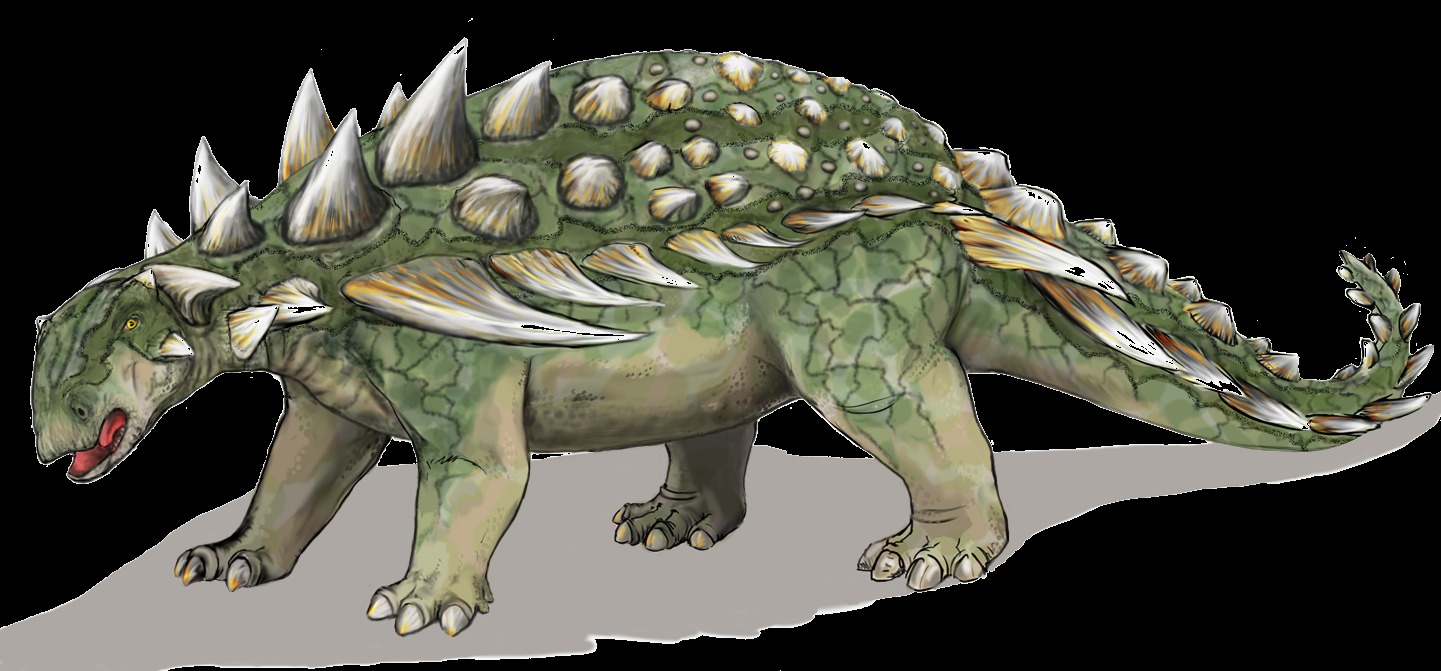
Gastonia was discovered in the Cedar Mountain Formation of Utah, USA. It lived during the Early Cretaceous period from 139 to 134.6 million years ago and is one of the very best known nodosaurids. Its name honours Robert Gaston, an American paleontologist and the CEO of Gaston Design, Inc., which makes and sells skeletal replicas of various and other prehistoric animals.
Gastonia represents one of the most formidable early ankylosaurs, combining features that would become hallmarks of later armored . Its body was a masterclass in defensive design, covered with an array of spikes, plates, and bony protrusions that would have made any predator think twice. The arrangement of its armor was particularly sophisticated, with different types of osteoderms serving different defensive purposes. Large shoulder spikes could deliver devastating wounds to attackers, while smaller armor plates provided comprehensive protection across the body. What’s remarkable about Gastonia is how it shows the rapid evolution of ankylosaur armor during the Early Cretaceous, setting the stage for the even more elaborate defensive systems that would follow.
Tuojiangosaurus: The Chinese Plate Bearer

Stegosauria include such species as the Late Jurassic Tuojiangosaurus from Asia, Kentrosaurus from Africa, Huayangosaurus from China, and Stegosaurus from America. While it looked somewhat like the stegosaurus, it had a double row of pointed plates ran along the tuojiangosaurus’s back. Its head was low and also narrower, while its body was large and bulky. The Tuojiangosaurus lived during the late Jurassic Period.
This Chinese stegosaur shows us how the basic stegosaurian body plan was adapted across different continents and environments. While sharing the fundamental characteristics of its North American relatives, Tuojiangosaurus had its own unique features that reflected local evolutionary pressures. The pointed nature of its plates suggests they may have served a slightly different function than the broader plates of Stegosaurus, possibly providing more effective protection against specific predators in its Asian environment. Its discovery helped paleontologists understand that stegosaurs were not just a North American phenomenon but had achieved global distribution, adapting their defensive strategies to local conditions while maintaining their distinctive appearance.
Euoplocephalus: The Well-Armored Head

One of the later thyreophorans is the Euoplocephalus, an ankylosaurid dinosaur that lived around 70 million years ago during the Late Cretaceous Period. It was 16-20 feet long and weighed over 2 tons. It had a wide, heavy body that was close to the ground, and a heavy club-like tail. The Euoplocephalus was discovered in Canada in 1897, and its name means “well-armored head”. Like other thyreophorans, the euoplocephalus looks tough, but ate plants using its horny beak-like snout to break off the leaves and stems.
What made Euoplocephalus truly remarkable was the completeness of its armor system. Ankylosaurians were stocky with heavy armor covering their bodies head to tail – some even had body armor on their eyelids! This level of protection was extraordinary even by thyreophoran standards. The name “well-armored head” doesn’t do justice to this dinosaur’s comprehensive defensive system. Every vulnerable point on its body was protected, from heavily armored eyelids to the massive tail club that could swing with devastating force. Living alongside predators like Albertosaurus and the mighty Tyrannosaurus rex, Euoplocephalus needed every bit of armor it could get, and evolution delivered a masterpiece of biological engineering that kept it safe in one of prehistory’s most dangerous ecosystems.
Conclusion
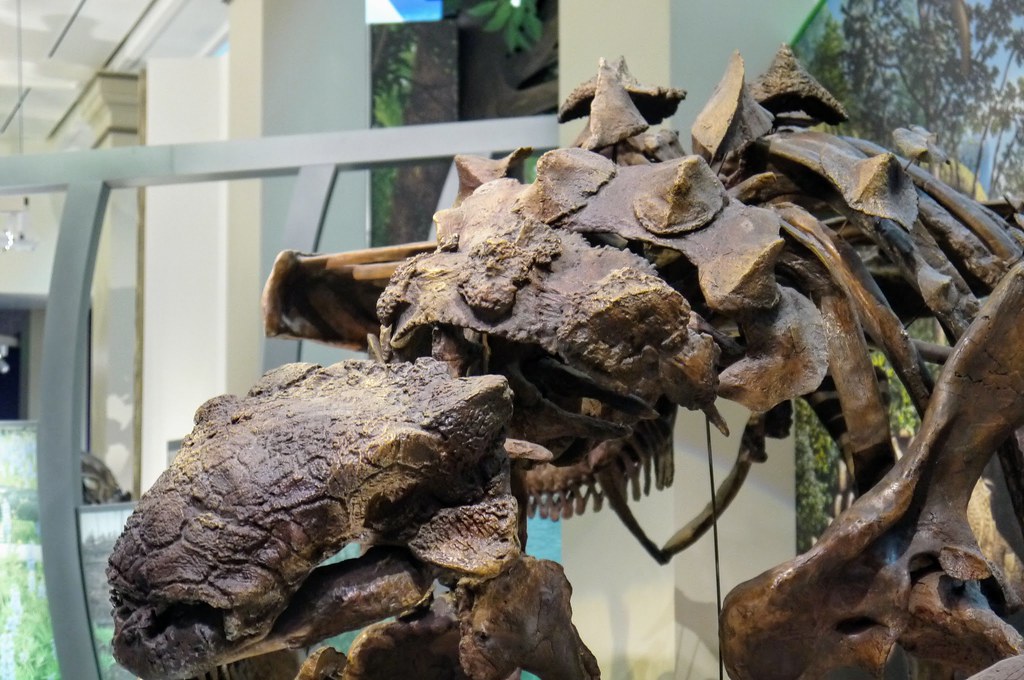
The story of thyreophorans is ultimately one of evolutionary ingenuity and the incredible diversity of solutions nature can devise for survival. And the strategy paid off: these did very well during their approximately 100 million years on Earth, spawning upward of 50 species. From the humble beginnings of Scutellosaurus with its scattered armor plates to the ultimate defensive achievements of Ankylosaurus and its massive tail club, these show us that sometimes the best offense is an impenetrable defense.
What strikes me most about these armored giants is how each species found its own unique solution to the challenge of staying alive in a world filled with massive predators. Whether through camouflage like Borealopelta, intimidating spikes like Kentrosaurus, or comprehensive armor coverage like Euoplocephalus, each thyreophoran carved out its own survival strategy. These weren’t just evolutionary accidents but sophisticated responses to environmental pressures that worked for over 135 million years. What do you think about these incredible armored ? Tell us in the comments.

